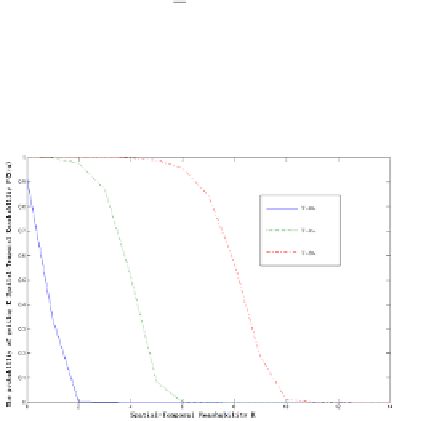Information Technology Reference
In-Depth Information
Step 4:
Probability for the network being K-Reachable
Our goal is to get the overall reachability for the whole network. In Theorem 1 we
acquired the probability for n nodes having Spatial-Temporal links with a certain node
S. In a large scale network, events can be seen as independent from each other[13, 14].
As a result, when
, we finally get the probability for all the nodes having at least
n Spatial-Temporal links, which means the network being K-Reachable:
N
>>
1
N
n
PX
(
≥=−
n
)
1
PX
(
=
j
)
=
(3)
j
=
0
N
m
N
−
m
CWindow
CWindow
C
m
N
*
*
1
−
S
S
N
map
map
i
m
−
i
n
j
mi
=
α
α
1
−
**
C
i
m
*1
−
π
π
j
i
==
00
ji
−
N ji
−
+
π
*
r
2
π
*
r
2
*
C
ji
N
−
*
*
1
−
S
S
map
map
Fig. 4.
Probability for the network being K-Reachable
With Message Life Time T=15s, analytical result shows probability for the network being 3-Reachable is
92%, while simulation shows 100%; when T=20s, analytical result shows probability for the network being
3-Reachable is 95%, while simulation indicates 100%.
5
Simulations and Discussions
In our simulation, we use C++ to build a Random Direction Model as an example for
DTN simulation environment. For Random Direction Model, we set node number
1000, map size 2000m*2000m, node moving speed 20m/s, transmitting range 100m.
We run the simulation 1000 times so that we can get the statistical distribution of n
nodes having Spatial-Temporal links with a certain node S within Message Life
Time T:





